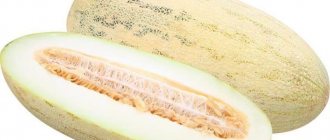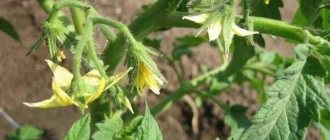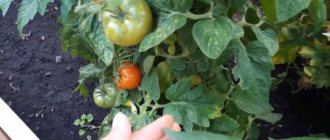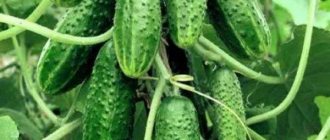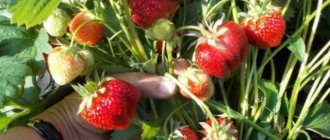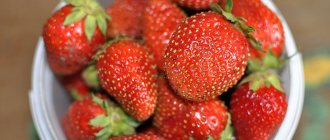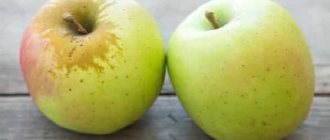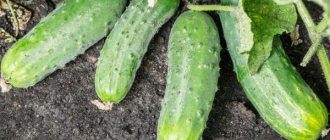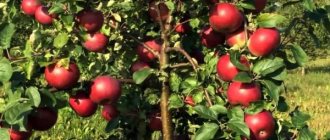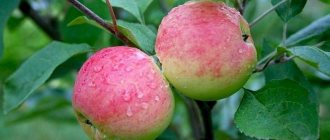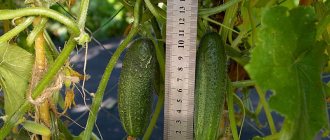Author's rating
Author of the article
Yakov Pavlovich
Professor, Head of the Department of Vegetable Growing
Articles written
153
Pineapple melons are becoming increasingly popular. The reason for this is the interesting taste. One cannot help but mention the possibility of growing a crop independently on your own plot, so as not to wait for it to appear on the shelves. Next, we will consider the features of agricultural technology, the advantages of the hybrid and the subtleties that will help grow pineapple melon.
Features of culture and beneficial properties
The fruits of the crop are characterized by an oval shape. The skin is thin, with a yellow-orange tint. The melon is dotted with a three-dimensional mesh. The weight of a ripe fruit is 1-2.5 kg. The area under the skin has a yellow or orange tint, and towards the edges it turns green. The pulp is tender, juicy and slightly oily. The hybrid has excellent taste and is distinguished by a light pineapple aroma.
Melon is beneficial for the human body. The fruit is used for ailments such as anemia, anemia, tuberculosis, gout, and rheumatism. It is also recommended to take the culture for problems with the respiratory tract, gastrointestinal tract and cardiovascular system.
general description
The high-yielding Pineapple melon is a mid-season and early variety. Depending on the variety, it matures from 60 to 100 days after planting. Loves warmth and light. From 9 to 15 kg of crop is harvested from one plant.
Type of bush
It is an annual plant with creeping stems and tendrils. Large alternate leaves are collected on the stems. Blooms with bisexual yellow flowers. The fruit is represented by pumpkin with different colors and specific taste.
Characteristics of the fetus
The fruits are oblong or round in shape and have a yellow-golden skin with a dense structure. The pulp is juicy and tender with a specific pineapple aroma. The fruits grow up to three kg.
The variety is suitable for long-term storage and tolerates transportation well. For two months it retains its taste and does not deteriorate.
Chemical composition and usefulness of melon
Like most other varieties, Pineapple melon is a source of vitamin PP, ascorbic acid, beta-carotene, riboflavin, thiamine, vitamin B5, and folic acid. It has a high energy value: 100 grams of product contains 38 kcal.
The best varieties and hybrids of pineapple melon
Pineapple melons are similar in properties, but there are several varieties of the crop. The most popular are:
- GOLD is a mid-season hybrid. Characterized by lumpy skin with a green tint. The pulp takes on different colors: from yellow to red. The taste of melon is sweet, sometimes cloying. There is a distinct smell of pineapple;
- Sweet pineapple F1 - refers to early ripening hybrids. They are erected in open ground and greenhouses. The fruits are small in size, the weight of one melon reaches 2 kg. Round shape. The peel is rough and has a green or brown mesh on the surface. The pulp is light yellow or orange. The taste of the hybrid is delicate, there is the taste and aroma of pineapple;
- American pineapple is a mid-season variety. They are erected in open ground. The hybrid is characterized by high yield and resistance to sub-zero temperatures. The fruits are round in shape and weigh 2.5 kg. The skin color is beige or light green. The pulp tastes like pineapple.
- Americano hybrid is classified as super-ripe. Melons grow small, the weight of one fruit is 400 g. The peel has a yellow tint and pronounced brown stripes. The inside of the melon is soft, juicy and has a subtle pineapple flavor.
See also Melon variety Amal f1: characteristics and cultivation features
Reviews of pineapple melon
Gardeners confirm that pineapple melons are easy to grow and have an unusual taste and aroma.
Irina, Belgorod: “I planted a pineapple melon on the recommendation of a neighbor and did not regret it. Growing a hybrid is no more difficult than the most common melon. The fruits are tasty, with an unusual aroma. I grew regular Pineapple, next year I want to try Americano, the mini-fruits in the photo look very interesting.”
Victoria, Krasnodar: “I have been growing the Pineapple melon variety for several years now. I like its juicy and sweet fruits. There really is a pineapple flavor. I don't use chemicals. I use silage, ash and mullein as fertilizer.”
Igor, Kursk: “Pineapple melons are my love. Already in early August I taste the first sweet fruits. The aroma is rich and the taste is sweet. We not only eat it raw, but also use it to make jam and candied fruits.”
Specifics of cultivation
The hybrid can be grown in the southern regions by direct sowing of seeds into the soil. Regions with cold climatic conditions are suitable for planting the variety in seedlings.
Choosing a location taking into account crop rotation
Pineapple melon is an unpretentious plant. It is erected on any soil, but a high yield can be obtained by planting plants on neutral soil. Choose a place that is sunny and free from drafts.
The optimal predecessors for the crop will be: cabbage, onions, turnips, corn, greens (except parsley), legumes, beets. A minimum of nutrients will remain for the melon if the plant is planted after cucumbers or pumpkins.
Timing of sowing scheme
Planting of pineapple melon begins depending on climatic conditions. The approximate period for sowing seeds is the end of spring - the third part of May. It is also necessary to focus on how the earth has warmed up. The soil temperature must be at least +15°C.
Expert opinion
Stanislav Pavlovich
Gardener with 17 years of experience and our expert
Ask a Question
Attention! Active growth of the crop is observed at a temperature of +25-30°C.
Seeds are not planted deeply. The maximum depth is 15-20 mm. You can speed up growth by covering the holes with polyethylene. The film must be removed when the first shoots appear.
Melon is planted at intervals of 80-100 cm from each other, since the crop is prone to active growth.
Conditions for growing seedlings
Before sowing, experienced gardeners recommend soaking the seeds. To do this, planting material is placed in warm water for several days. The fluid is changed daily. From the moment they hatch, the seeds are ready to be planted in the soil.
Strictly one seed is placed in one container. To create a greenhouse effect, each cup is covered with film. The container with seedlings is placed in a lighted place. To prevent the seedlings from stretching, the cups are regularly turned over.
After 30 days, the plants are ready for planting in open soil. Before this, melons must be hardened. To do this, glasses with seedlings are taken out into the open air every day.
Further care
Proper care of the crop is a guarantee of a healthy harvest.
Watering the beds
Pineapple melon needs to be watered constantly. The liquid consumption is 500 ml per plant. Over time, the volume is increased to 3 liters.
Watering is reduced at the flowering stage of the crop. At this time, the beds are moistened once every 5 days. During the period of fruit ripening, irrigation is further reduced. About a week before harvest, the beds completely stop being watered.
What and how to feed pineapple melon
For convenience, watering is combined with fertilizing. Fertilizers are applied according to the following scheme:
- 14 days after placing the seedlings in open ground: 2 liters of nutrient mixture are sent to each plant (20 g of ammonium nitrate per 10 liters of liquid);
- at the budding stage: feeding with mullein or ammonia solution;
- 14-21 days after the last feeding they resort to mineral fertilizers.
Soil care
To prevent stagnation of liquid and for better oxygen supply to the root system, the soil in the beds should be loosened regularly. At first, the procedure is carried out every week, then less often. As soon as the crop begins to form lateral stepsons, the melon is hilled up. Weeds are also systematically removed.
Protection from pests and diseases
Pineapple melon is susceptible to diseases characteristic of other melon crops. In particular, we are talking about spider mites, cutworms, wireworms, aphids, etc. The plant is also susceptible to diseases such as downy mildew, fusarium, and copperhead.
See also Melon Kolkhoznitsa - what is it good for the body
In order to protect crops from diseases and pests, various methods are used. One of the most popular is the placement of eggshells and onion peels in the holes before planting. Also, for prevention purposes, the crop is sprayed with solutions based on soap, garlic or onions. The planting can be protected by planting marigolds or other plants with a distinct aroma near the melon.
Pests and diseases
Melon crops are susceptible to diseases such as anthracnose, powdery mildew and late blight, but pineapple melon is immune to them. However, it can be attacked by insects. The most common pests of melon are whiteflies, mites, wireworms, cutworms, melon flies, and copperheads.
Treating the bushes with an aqueous solution of ash or laundry soap with whey helps against these insects. If plants are severely damaged, insecticides can be used.
You can reduce the risk of pest invasion on plantings by taking simple preventive measures:
- Place some onion peels in the planting holes;
- From time to time, treat the plants with laundry soap dissolved in water. A decoction of onion or garlic gives a good result;
- sow plants with a strong smell, such as onions or garlic, next to the melon.
Signs of ripeness and harvest rules
You can start harvesting only after making sure that the pineapple melon is completely ripe. First of all, pay attention to the shade of the fruit or the mesh with which they are covered. Ripe specimens easily lag behind the vines and are distinguished by a specific shade. The mesh on the peel spreads evenly around the entire perimeter of the fruit. However, it is worth noting that such melons cannot be stored for a long time. The maximum time they will last is only 1.5 months.
If the gardener plans to store the crop for a long time, you need to pick melons from the beds with a medium mesh that does not cover the entire fruit.
Harvesting is carried out in the morning (before the heat sets in) or in the evening. The picked melons are not collected from the ground for several days, turning over every 6 hours. Afterwards they can be stored in a cool, dry place.
Expert opinion
Stanislav Pavlovich
Gardener with 17 years of experience and our expert
Ask a Question
Attention! Melons that are supposed to be stored for a long time are picked so that a tail of at least 3 cm remains.
Characteristics of the variety
There are many varieties, but they were all bred by breeders, and therefore adapted to difficult weather conditions.
They are grown in both the south and north of the country. The growing season for early varieties is approximately 70 days, and for mid-season varieties – up to 90 days.
Pineapple melon is relatively resistant to powdery mildew, late blight and most fungal diseases.
The varieties are characterized by high productivity. This melon is eaten both fresh and processed (juices, jam, candied fruits, etc.).
Useful tips from experienced gardeners
In general, there should be no problems with growing hybrids, since during the breeding period the varieties concentrated the positive qualities of the crop as much as possible. However, there are several subtleties, if observed, you can be guaranteed a high yield.
First of all, experienced gardeners recommend choosing planting material wisely. Preference is given not only to proven varieties, but also to the place where the seeds are purchased. It is better to pay attention to trusted manufacturers. The envelope with seeds must contain complete information about the product. It is better to buy planting material in specialized stores.
If you want to prepare the seeds yourself, then at least three years must pass before planting.
